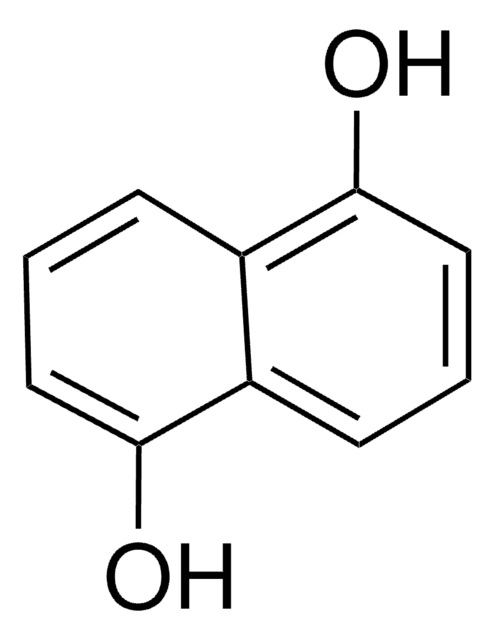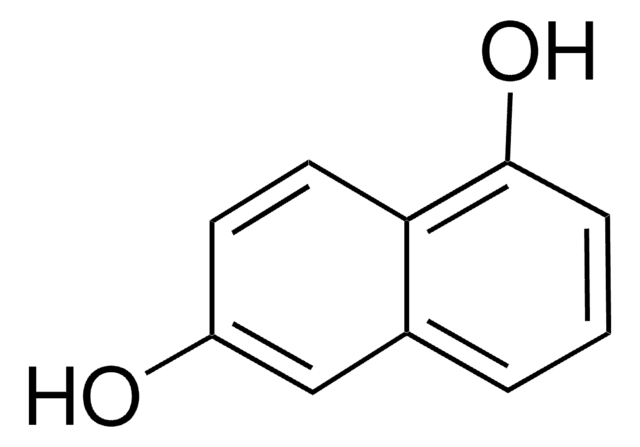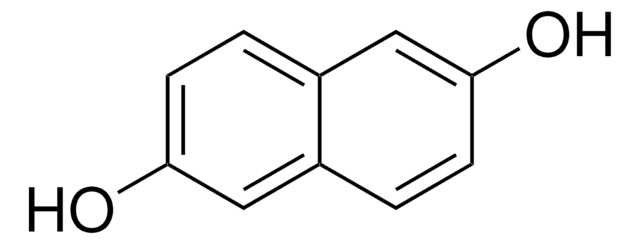37760
2,3-Dihydroxynaphthalene
≥98.0% (HPLC)
Sinónimos:
2,3-Naphthalenediol
Iniciar sesiónpara Ver la Fijación de precios por contrato y de la organización
About This Item
Fórmula lineal:
C10H6(OH)2
Número de CAS:
Peso molecular:
160.17
Beilstein:
742375
Número CE:
Número MDL:
Código UNSPSC:
12352100
ID de la sustancia en PubChem:
NACRES:
NA.22
Productos recomendados
Nivel de calidad
Ensayo
≥98.0% (HPLC)
residuo de sublimación
≤1%
mp
161-165 °C (lit.)
162-164 °C
cadena SMILES
Oc1cc2ccccc2cc1O
InChI
1S/C10H8O2/c11-9-5-7-3-1-2-4-8(7)6-10(9)12/h1-6,11-12H
Clave InChI
JRNGUTKWMSBIBF-UHFFFAOYSA-N
Información sobre el gen
human ... BAD(572)
¿Está buscando productos similares? Visita Guía de comparación de productos
Categorías relacionadas
Descripción general
2,3-Dihydroxynaphthalene is a polyhydroxy phenol. It is an aromatic dihydroxy compound having hydroxyl groups at ortho positions. Its reaction with molybdenum(VI) complexes has been reported. The asymmetric oxidative coupling polymerization of 2,3-dihydroxynaphthalene using the Cu(I)-bisoxazoline complex as catalyst has been reported to afford poly(2,3-dihydroxy-1,4-naphthylene), having a continuous 1,1′-bi-2-naphthol main chain structure. The nitrodisplacement reaction between nitrophthalodinitriles and 2,3-dihydroxynaphthalene has been investigated.
Aplicación
2,3-Dihydroxynaphthalene may be used in the following studies:
- Construction of dinaphtho[2,1-b;2′,3′-d]furan-6-ol, via dehydration reaction in the presence of strong acid.
- As fused ring catecholate type ligand for the surface modification of nanocrystalline TiO2 particles.
- As adsorptive and competing ligand during the chemical speciation of iron in seawater by cathodic stripping voltammetry.
- Synthesis of cyclotriphosphazene derivatives, used as non-halogen flame retardants
Palabra de señalización
Danger
Frases de peligro
Consejos de prudencia
Clasificaciones de peligro
Acute Tox. 4 Oral - Eye Dam. 1
Código de clase de almacenamiento
11 - Combustible Solids
Clase de riesgo para el agua (WGK)
WGK 3
Punto de inflamabilidad (°F)
347.0 °F
Punto de inflamabilidad (°C)
175 °C
Equipo de protección personal
dust mask type N95 (US), Eyeshields, Gloves
Elija entre una de las versiones más recientes:
¿Ya tiene este producto?
Encuentre la documentación para los productos que ha comprado recientemente en la Biblioteca de documentos.
Los clientes también vieron
Copper (I)-catalyzed asymmetric oxidative coupling polymerization of 2, 3-dihydroxynaphthalene using bisoxazoline ligands.
Habaue S, et al.
Macromolecules, 36(8), 2604-2608 (2003)
Application of cyclophosphazene derivatives as flame retardants for ABS.
Shin YJ, et al.
Journal of Industrial and Engineering Chemistry (Amsterdam, Netherlands), 16(3), 364-367 (2010)
Tatjana D Savić et al.
Nanoscale, 4(5), 1612-1619 (2012-02-09)
Surface modification of nanocrystalline TiO(2) particles (45 Å) with catecholate-type ligands consisting of an extended aromatic ring system, i.e., 2,3-dihydroxynaphthalene and anthrarobin, was found to alter the optical properties of the nanoparticles in a similar way to modification with catechol.
Synthesis of bis (ether anhydride) s for poly (ether imide) s having 1, 2-linked units by nitrodisplacement with catechol derivatives.
Eastmond GC and Paprotny J.
Macromolecules, 28(7), 2140-2146 (1995)
Kentaro Nakanishi et al.
The Journal of organic chemistry, 79(6), 2625-2631 (2014-02-26)
The construction of dinaphtho[2,1-b;2',3'-d]furan-6-ol was developed via a dehydration reaction involving two molecules of 2,3-dihydroxynaphthalene in the presence of a strong acid. Starting from the dinaphthofuran, a variety of butterfly shaped derivatives were synthesized. The optical properties of these compounds
Nuestro equipo de científicos tiene experiencia en todas las áreas de investigación: Ciencias de la vida, Ciencia de los materiales, Síntesis química, Cromatografía, Analítica y muchas otras.
Póngase en contacto con el Servicio técnico











